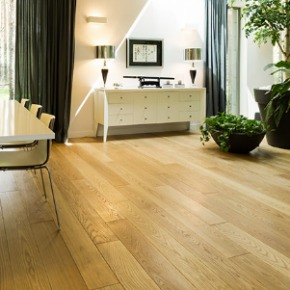
Engineered Wood Flooring Vs Hardwood Flooring – Lifestyle Flooring investigate
Lifestyle Flooring have taken a look at the essential difference between engineered wood flooring and hardwood flooring, with the intention of it helping people make informed decisions.
Engineered and hardwood both feature solid wood, but the way they are built and the features they possess make them entirely different. The type of floor chosen will depend a lot on the space, where you want to use the floor in and the way it is used.
Manufacture
Engineered wood floors feature a multi-layer design. The top layer, also called the wear layer, features solid wood, while the core layer is made of solid hardwood, softwood or plywood.
The number of layers used varies from each manufacturer and can range from two layers to twelve layers. All layers are bonded to each other under specific temperature and pressure.
Solid hardwood flooring, on the other hand, consists of solid hardwood planks derived from a single unit of lumber through factory machining.
Re-Sanding Capability
Engineered wood floors are available in varying degrees of thickness, ranging from 1mm to 5mm. The thicker the wear layer, the more the floor can be re-sanded.
Most solid hardwood floors are available in a standard thickness of ¾inch. However, some floors are thinner at 5/16” thickness. These floors can be re-sanded multiple times without compromising their structural integrity.
Usage for Engineered Wood & Hard Wood
Thanks to their layered construction, engineered wood floors can be installed anywhere in a building including the basement. The layered construction of the floors imparts excellent dimensional stability to them.
This means that these floors do not bulge or shrink owing to temperature and humidity changes. Engineered wood floors can be used in basements, conservatories and kitchens, without a second thought.
However, solid hardwood flooring is not resistant to such changes, meaning it is not recommended for moisture-prone areas like basements. They are ideally suited for above-level floors such as first, second and third levels.
If a consistent look is desired, an engineered wood floor would be a better option.
Performance
Engineered wood floors are constructed to offer better resilience than solid hardwood floors. You will find engineered floors are sturdier and better-performing compared to solid hardwood floors. With right maintenance, they can last a lifetime.
Solid hardwood flooring is great to have, but the performance depends on the type of solid wood. For example, a pine floor is a poor selection for areas experiencing heavy traffic or in kitchens and households with kids and active pets.
In spaces such as these, denser woods are appropriate, as they can handle scratches and dents better.
Whether it be engineered wood floors or hardwood floors, Lifestyle Flooring offers a fine selection of high-quality flooring, from some of the best manufacturers worldwide. We encourage people request free samples before an order is placed, so a more informed decision can be made.
One comment on “Engineered Wood Flooring Vs Hardwood Flooring – Lifestyle Flooring investigate”
Leave a Reply
You must be logged in to post a comment.
Latest news

28th March 2025
Ideal Heating Commercial announces 10-year warranty on Evomax 2 boiler
Evomax 2, the UK’s number one selling commercial wall-mounted boiler from Ideal Heating Commercial, is now available with a 10-year warranty.
Posted in Articles, Building Industry News, Building Products & Structures, Building Regulations & Accreditations, Building Services, Facility Management & Building Services, Heating Systems, Controls and Management, Heating, Ventilation and Air Conditioning - HVAC, Innovations & New Products, Pipes, Pipes & Fittings, Plumbing, Retrofit & Renovation, Sustainability & Energy Efficiency, Videos
28th March 2025
FLIR Si1-LD Acoustic Imaging Camera for Compressed Air Leak Detection
FLIR, a Teledyne Technologies company, introduces the Si1-LD, an industrial acoustic imaging camera that brings faster and more accurate compressed air leak detection to those operating on a modest condition monitoring budget.
Posted in Acoustics, Noise & Vibration Control, Articles, Building Industry News, Building Products & Structures, Building Services, Facility Management & Building Services, Information Technology, Innovations & New Products, Retrofit & Renovation, Sustainability & Energy Efficiency, Thermal Imaging and Monitors
28th March 2025
LIFTEX 2025 Seminar programme announced
Registration has opened for LIFTEX 2025. Now in its 37th year, LIFTEX 2025 is the UK’s only dedicated exhibition for the lift, escalator and access industry and takes place only once every three years.
Posted in Access Control & Door Entry Systems, Accessibility, Articles, Building Industry Events, Building Industry News, Building Products & Structures, Building Regulations & Accreditations, Building Services, Exhibitions and Conferences, Facility Management & Building Services, Health & Safety, Retrofit & Renovation, Security and Fire Protection, Seminars
28th March 2025
MCRMA welcomes ArcelorMittal UK to membership
A UK division of the global steelmaking business ArcelorMittal has become the latest new member of the MCRMA, the industry association representing the metal building envelope sector.
Posted in Articles, Building Associations & Institutes, Building Industry News, Building Products & Structures, Building Systems, Cladding, Facades, Posts, Restoration & Refurbishment, Retrofit & Renovation, Roofs, Steel and Structural Frames, Walls

Are your product lines similar in appearance between engineered wood and hardwood? When I think of layered my first thought is how plywood is layered. Is the engineered wood similar of this in appearance?